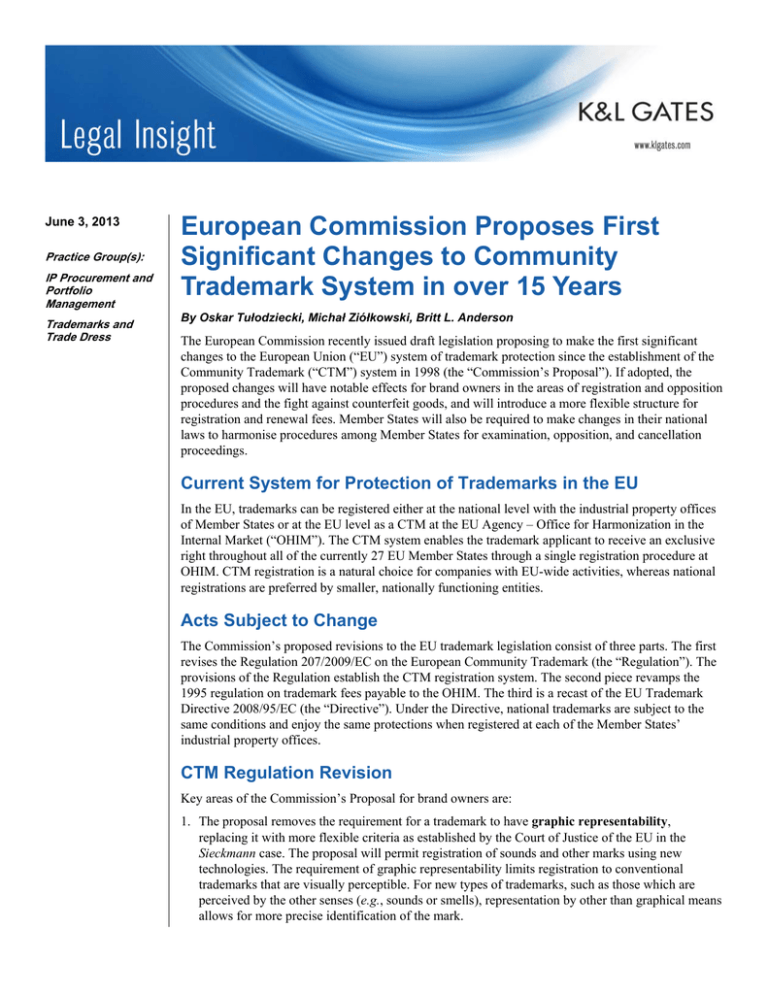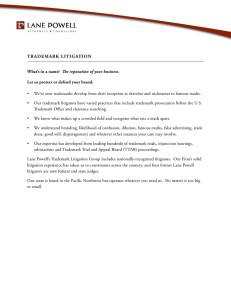
June 3, 2013
Practice Group(s):
IP Procurement and
Portfolio
Management
Trademarks and
Trade Dress
European Commission Proposes First
Significant Changes to Community
Trademark System in over 15 Years
By Oskar Tułodziecki, Michał Ziółkowski, Britt L. Anderson
The European Commission recently issued draft legislation proposing to make the first significant
changes to the European Union (“EU”) system of trademark protection since the establishment of the
Community Trademark (“CTM”) system in 1998 (the “Commission’s Proposal”). If adopted, the
proposed changes will have notable effects for brand owners in the areas of registration and opposition
procedures and the fight against counterfeit goods, and will introduce a more flexible structure for
registration and renewal fees. Member States will also be required to make changes in their national
laws to harmonise procedures among Member States for examination, opposition, and cancellation
proceedings.
Current System for Protection of Trademarks in the EU
In the EU, trademarks can be registered either at the national level with the industrial property offices
of Member States or at the EU level as a CTM at the EU Agency – Office for Harmonization in the
Internal Market (“OHIM”). The CTM system enables the trademark applicant to receive an exclusive
right throughout all of the currently 27 EU Member States through a single registration procedure at
OHIM. CTM registration is a natural choice for companies with EU-wide activities, whereas national
registrations are preferred by smaller, nationally functioning entities.
Acts Subject to Change
The Commission’s proposed revisions to the EU trademark legislation consist of three parts. The first
revises the Regulation 207/2009/EC on the European Community Trademark (the “Regulation”). The
provisions of the Regulation establish the CTM registration system. The second piece revamps the
1995 regulation on trademark fees payable to the OHIM. The third is a recast of the EU Trademark
Directive 2008/95/EC (the “Directive”). Under the Directive, national trademarks are subject to the
same conditions and enjoy the same protections when registered at each of the Member States’
industrial property offices.
CTM Regulation Revision
Key areas of the Commission’s Proposal for brand owners are:
1. The proposal removes the requirement for a trademark to have graphic representability,
replacing it with more flexible criteria as established by the Court of Justice of the EU in the
Sieckmann case. The proposal will permit registration of sounds and other marks using new
technologies. The requirement of graphic representability limits registration to conventional
trademarks that are visually perceptible. For new types of trademarks, such as those which are
perceived by the other senses (e.g., sounds or smells), representation by other than graphical means
allows for more precise identification of the mark.
European Commission Proposes First Significant Changes
to Community Trademark System in over 15 Years
2. The one-month period for payment of CTM application fees will be abolished. The Commission’s
Proposal links the payment obligation to the filing of the application, so that applicants will be
required to provide evidence that they have submitted their payment when filing their application.
3. The requirement for priority searches, which are conducted by OHIM and sent to applicants during
the registration process, will be abolished. This change will speed up the registration procedure by
eliminating the current one-month period between the notice to applicant of search reports and
publication of the application. Applicants often had little interest in the results of trademark
searches of national offices, and OHIM now offers a publically available search tool, TMView,
intended as the platform for data from all 27 EU Member States in addition to the information
available from OHIM and World Intellectual Property Organization (WIPO).
4. Any natural person or legal entity will be able to submit “observations” against a newly filed CTM
application, explaining why a given trademark should not be registered ex officio. Such entities,
unlike those filing oppositions after the publication of an application, will not be parties to the
proceedings before the OHIM. The deadline for filing observations will continue to be at the end
of the opposition period.
5. Several changes are intended to improve the fight against counterfeit goods. First, trademark
owners will be given a broader right to prevent importation of counterfeit goods into the EU,
ensuring that a trademark owner can prevent businesses – whether located in the EU or not – from
selling counterfeit goods to private consumers, and discouraging the purchase and sale of
counterfeit goods over the internet. In addition, the proposal provides owners of CTM registrations
with the right to prevent third parties from bringing goods with counterfeit marks into the customs
territory of the EU, even if the goods with counterfeit marks are not released into free circulation.
This change is intended to address the heavily criticized judgment of the Court of Justice of the EU
in Philips/Nokia, in which the in-transit movement of non-EU goods was held not to infringe
trademark and other intellectual property rights under EU law and the Member States. The
proposal aims to fill the gap in protection against counterfeit goods left by Philips/Nokia,
effectively lowering the burden of proof imposed on rights holders. Finally, the proposal includes a
rule allowing proceedings against the distribution of counterfeit labels and packaging that may
subsequently be combined with infringing goods.
6. Protection of geographical indications under EU law will be given full effect as an absolute ground
for refusal during CTM registration proceedings. Grounds for refusal will be extended to cover
protected traditional specialties and wines.
7. As a consequence of the entry into force of the Lisbon Treaty, the terminology of the CTM
Regulation is to be modified. This means changing “Community trade mark (CTM)” to “European
trade mark (ETM).” Also, the OHIM name will be changed to “European Union Trade Marks and
Designs Agency (EUTMDA).”
The proposed CTM Regulation will be transmitted to the European Parliament and the Council for
adoption under the co-decision procedure. Most amendments of the CTM Regulation, if accepted, will
become effective when it enters into force, most likely in mid-2014.
Commission Regulation Pertaining to OHIM Fees Also Subject to
Change
Currently trademark applicants are asked to pay an application fee of 900 euro, which can be extended
to three classes of goods and services. Under the proposed new structure, a one-class-per-fee system
2
European Commission Proposes First Significant Changes
to Community Trademark System in over 15 Years
will apply, where a separate class fee is paid for each additional good or service class beyond the first.
The new system will provide applicants with considerably more flexibility.
The basic official fee for CTM registration will be 775 euro for one class, 825 euro for two classes and
900 euro for three classes (plus 150 euro for the fourth and subsequent classes). Renewal fees will also
be decreased, starting from 1000 euro for renewal in one class, 1100 euro for two classes and 1250
euro for three classes. The amendments to the Fees Regulation are expected to be adopted before the
end of 2013.
Recast of the EU Trademark Directive
Proposed changes under the Directive will have a significant impact on certain national systems
relating to: (i) establishment of administrative opposition or cancellation procedures in those EU
Member States where such administrative procedures do not yet exist, and such cases are currently
heard by civil courts, (ii) restriction of ex officio examination to absolute grounds in the EU Member
States where relative examination is still conducted, and (iii) the introduction of a one-class-per-fee
system.
The chart below reflects the current differences in these procedures among EU Member States and
OHIM:
Issue
Yes
No
Availability of administrative
opposition procedure
Austria, Benelux, Bulgaria,
Cyprus, Czech Republic,
Denmark, Estonia, Finland,
France, Germany, Greece,
Hungary, Ireland, Italy,
Lithuania, Latvia, Poland,
Portugal, Romania, Slovakia,
Slovenia, Spain, Sweden, UK,
OHIM
Malta
Availability of administrative
cancellation procedure
Austria, Bulgaria, Cyprus,
Czech Republic, Denmark,
Germany, Greece, Hungary,
Ireland, Italy, Poland, Portugal,
Slovakia, UK, OHIM
Benelux, Estonia, Spain,
Finland, France, Lithuania,
Latvia, Malta, Romania,
Slovenia, Sweden
Ex officio examination of
relative grounds during the
process of registration
Cyprus, Czech Republic,
Estonia, Finland, Greece,
Ireland, Malta, Poland,
Portugal, Slovakia, Sweden
Austria, Benelux, Bulgaria,
Denmark, France, Germany,
Hungary, Italy, Lithuania,
Latvia, Romania, Slovenia,
Spain, UK, OHIM
Existence of the one-class-perfee system
Cyprus, Estonia, Greece,
Ireland, Italy, Lithuania, Latvia,
Malta, Portugal, Romania,
Sweden, Spain, UK
Austria, Benelux, Bulgaria,
Czech Republic, Denmark,
Finland, France, Germany,
Hungary, Poland, Slovakia,
Slovenia, OHIM
3
European Commission Proposes First Significant Changes
to Community Trademark System in over 15 Years
The legislative proposals of the Directive will be transmitted to the European Parliament and the
Council for adoption under the co-decision procedure. This proposal is due to be adopted by the
Spring of 2014. Then all EU Member States will have two years to transpose the new rules of the
Directive into their national laws.
Authors:
Oskar Tułodziecki
oskar.tulodziecki@klgates.com
+48.22.653.4211
Michał Ziółkowski
michal.ziolkowski@klgates.com
+48.22.653.4291
Britt L. Anderson
britt.anderson@klgates.com
+1.650.798.6746
Anchorage Austin Beijing Berlin Boston Brisbane Brussels Charleston Charlotte Chicago Dallas Doha Dubai Fort Worth Frankfurt
Harrisburg Hong Kong Houston London Los Angeles Melbourne Miami Milan Moscow Newark New York Orange County Palo Alto Paris
Perth Pittsburgh Portland Raleigh Research Triangle Park San Diego San Francisco São Paulo Seattle Seoul Shanghai Singapore Spokane
Sydney Taipei Tokyo Warsaw Washington, D.C. Wilmington
K&L Gates practices out of 48 fully integrated offices located in the United States, Asia, Australia, Europe, the
Middle East and South America and represents leading global corporations, growth and middle-market companies,
capital markets participants and entrepreneurs in every major industry group as well as public sector entities,
educational institutions, philanthropic organizations and individuals. For more information about K&L Gates or its
locations, practices and registrations, visit www.klgates.com.
This publication is for informational purposes and does not contain or convey legal advice. The information herein should not be used or relied upon in
regard to any particular facts or circumstances without first consulting a lawyer.
©2013 K&L Gates LLP. All Rights Reserved.
4



